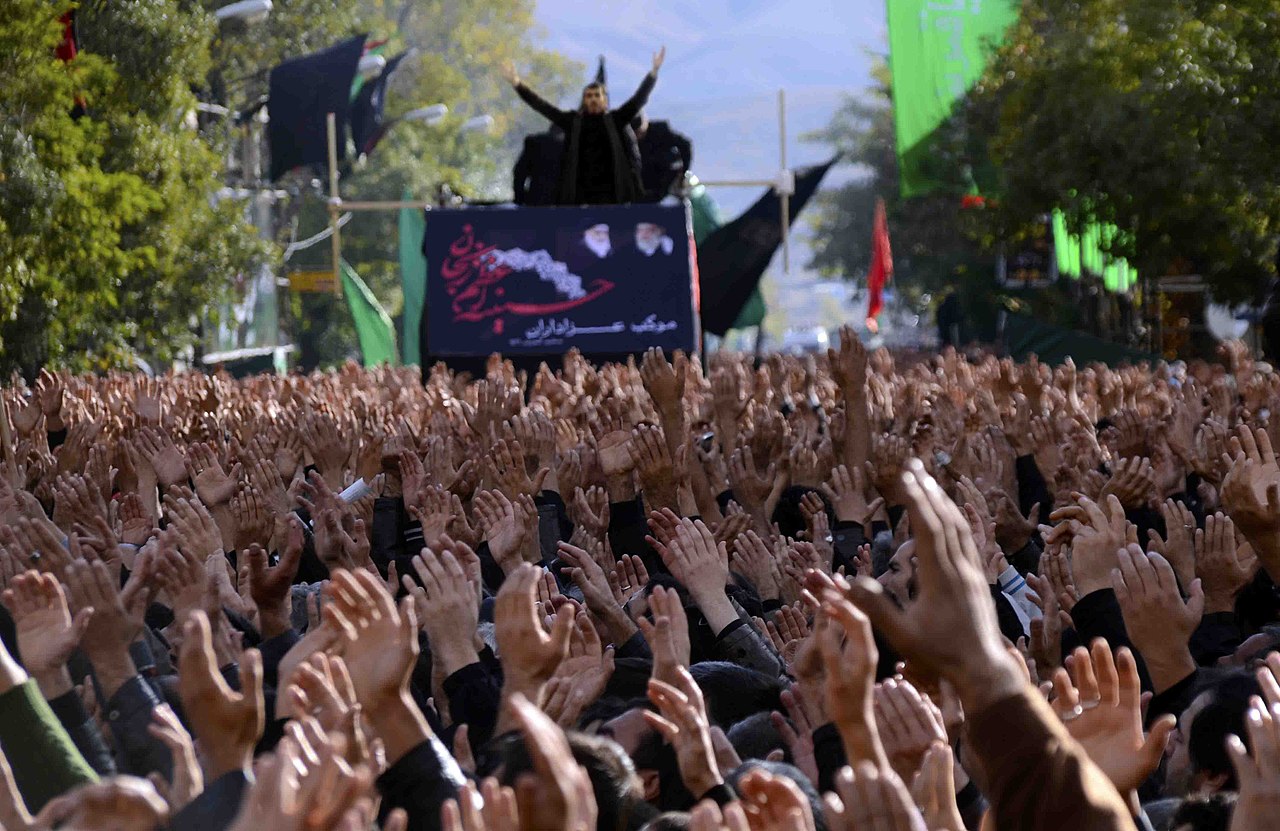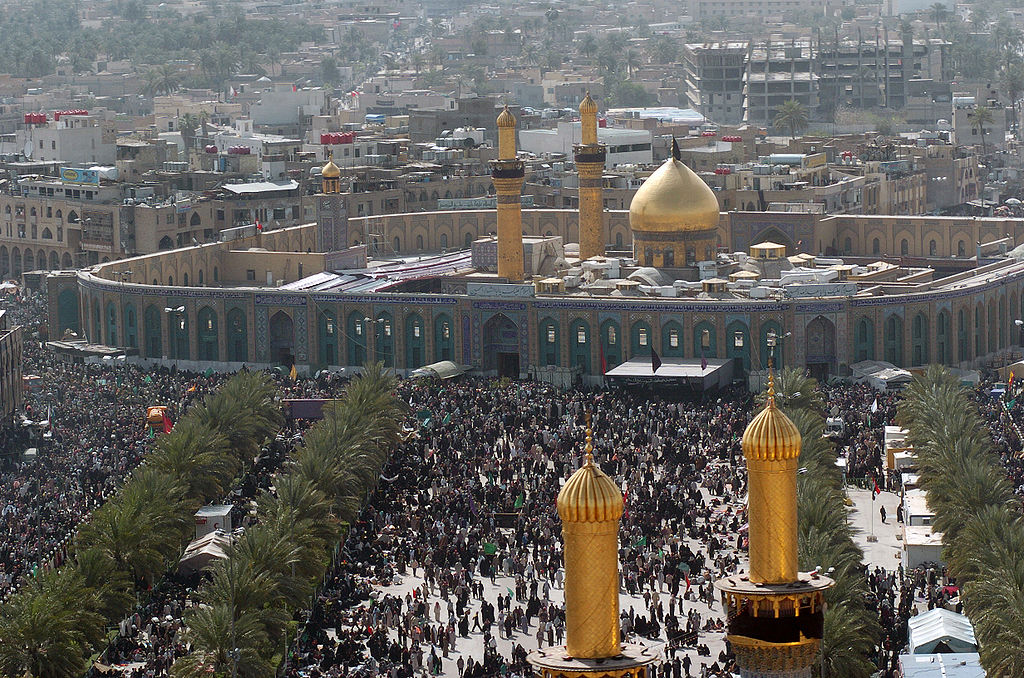Find out more about The Open University's Religious Studies qualifications.
Ashura is the tenth day of Muharram, the first month of the Muslim lunar calendar. Muslims associate it with the prophet Moses and the Israelites’ miraculous escape from Egypt. During this time, Muslims believe that God withdrew the water from part of the Red Sea to enable them to cross on its dry bed. God then let the water flow back so that their Egyptian pursuers were all killed (see Hebrew Bible/Old Testament Exodus: 14; Qur’an 26: 63–68).
There are two principal traditions within Islam – Sunni and Shi‘a; between 80 and 85% of Muslims belong to the Sunni tradition and between 15 and 20% to the Shi‘a one. Ashura is much more important for Shi‘a Muslims than it is for Sunni Muslims. On Ashura, Sunni Muslims are encouraged to fast, read the Qu’ran, offer extra prayers, and give to charities. For Shi‘a Muslims, Ashura is the climax of a sequence of mourning rituals which begin on the first day of Muharram. This is because it was on Ashura in 680 CE that the Prophet Muhammad’s grandson, Imam Husayn, was killed in a battle at Karbala in southern Iraq.
 The local Shiite muslim pilgrims celebrating the Ashura festival in Shiraz City, Iran.
The local Shiite muslim pilgrims celebrating the Ashura festival in Shiraz City, Iran.
The background to this was a dispute that developed within the early Muslim community over who should be its leader. Some Muslims argued that before his death Muhammad nominated his cousin, Ali, to succeed him as leader of the Muslim community when he died. In the event Muhammad’s close friend and companion, Abu Bakr, became the first Caliph (deputy or successor). Ali did eventually become Caliph in 656 CE. Five years later, however, Ali was assassinated, and Mu‘awiya took control of the rapidly expanding Muslim empire. Mu‘awiya, like Muhammad and Ali, also came from Mecca, but he belonged to a different clan, the Umayyads.
Some Muslims regarded Mu‘awiya as a usurper who had no right to rule. Muhammad’s daughter Fatima had married Ali, and they had two sons, Hassan and Husayn. Those who opposed Mu’awiya believed that because they were Muhammad’s grandchildren one of the sons should have become Caliph after Ali’s death. When Mu‘awiya died in 680 CE, his son Yazid succeeded him as Caliph. The people of Kufa, a city in southern Iraq, responded by inviting Husayn, Ali and Fatima’s younger son, to lead them in a movement of opposition to him. Husayn accepted the invitation and with a small party of close family members and friends, he set out for Kufa from Medina where he had been living. A large detachment of soldiers sent by the governor of Iraq, a supporter of Yazid, intercepted them at Karbala. Though the people of Kufa had invited him to their city, they did nothing to help, and Husayn’s party suffered terribly from thirst in the heat of the desert. After several days the soldiers attacked. Husayn and his supporters resisted bravely but were defeated. He and nearly all the other male members of his party were killed, including Husayn’s youngest son, the infant Ali Asghar. Husayn’s son, Ali Zainu’l-Abidin, was spared because he was too ill to fight. The women were taken prisoner, but after some time Yazid released them.
 Battle of Karbala, Iranian painting, oil on canvas, 19th century.
Battle of Karbala, Iranian painting, oil on canvas, 19th century.
It is this massacre that the Shi‘a (the word comes from the Arabic shi‘at ali, or ‘party’ of Ali) commemorate on Ashura. Shi‘a Muslims came to see Husayn and his family as having sacrificed themselves to uphold the ideals of early Islam and make a stand against Yazid who had no right to rule the empire. Because of Husayn’s willingness to suffer and die at Karbala, God is believed to have granted him the power to intercede for Muslims on the Day of Judgement, when those who have followed God’s commandments will be admitted to paradise and those who have ignored them will be consigned to hell. Most Shi‘a Muslims therefore believe that participating in and sharing Husayn and his family’s suffering at Karbala will help them to obtain salvation, and they do this in various ways.
The best-known of these is perhaps the pilgrimage to Karbala where Husayn was buried after the battle. His tomb became a major pilgrimage centre for Shi‘a Muslims and nowadays hundreds of thousands of people visit it at Ashura to take part in various mourning rituals including processions commemorating Husayn’s martyrdom. During these, they strike their chests with their hands and hit their backs with chains to the beat of clashing cymbals and drums.
 Shi‘as mourning in Iran.
Shi‘as mourning in Iran.
Processions also take place elsewhere in Iraq, and in Iran, Lebanon, Pakistan and India and other parts of the world where there is a significant Shi‘a population. Usually, the streets are hung with banners and flags, and those taking part will dress in black and may carry various ritual objects such as replicas of Husayn’s coffin, his tomb or his body, portable shrines with images of Husayn, and standards decorated with cloths and ribbons, and topped with metal crests of various designs. These include stylised two-dimensional hands, the fingers and thumb representing the Prophet Muhammad, his daughter Fatima, Ali and Husayn and his brother Hassan.
In Iranian processions, women may carry a replica of a cradle on poles to commemorate the death of Husayn’s youngest son, Ali Asghar, at Karbala. Particularly striking is the way that in the city of Yazd in southern Iran mourners carry a huge wooden structure representating of Husayn’s tomb on their shoulders. In some places, in Hyderabad in India for instance, mourners may cut their chests and scalps with knives and razors to make the blood flow in order to re-enact ‘the spilling of Husayn’s blood at Karbala’ (Ashura: Encyclopedia of World Religions/Encyclopedia of Islam).
 Young men mourn during the day of Ashura in Istanbul.
Young men mourn during the day of Ashura in Istanbul.
Shi‘a Muslims also commemorate the 40th day after Ashura, Arbaeen, and in the days leading up to it huge numbers of pilgrims walk the 50 or so miles from Najaf (where Ali is buried) to Karbala where they take part in further mourning rituals for Husayn and his family. Reportedly, this is the largest public gathering in the contemporary world.
For Shi‘a muslims too Muharram is also a time for charity. People will feed the poor and those taking part in the processions. People may also host gatherings where those attending listen to recitations of narratives and poems focusing on the events at Karbala. The recitations dwell on the sufferings of Imam Husayn and his family, with the aim of making their listeners cry and lament in sympathy for them because this will also help to earn his intercession. Another feature of Muharram, particularly in Iran, is re-enactments of the Karbala events. These are performed by actors who take on the parts of Husayn and his family and those responsible for their deaths, including Shimr, Husayn’s killer. Ashura processions in India and Pakistan may feature a stallion to represent Husayn’s horse, Zuljenah, who died with him at Karbala.
Since the nineteenth century CE, and particularly during the late twentieth century CE, Ashura and its meanings have continued to evolve. Nowadays in many Shi‘a communities around the world, particularly in the UK for example, people will donate blood to medical charities instead of cutting or beating themselves. British Shi‘a Muslims also hold processions to commemorate Ashura; for instance, one has been held in central London for more than thirty years. In 680 CE Husayn tried to reach Kufa to lead a movement of opposition to the Caliph Yazid, and particularly since the mid-twentieth century Shi‘a Muslims have often argued that the significance of Ashura is political as well as a religious and that Husayn’s martyrdom should inspire them to resist tyranny and oppression.
Further reading:
- If you would like to read more about Ashura and Shi‘a Islam you might enjoy an article from 2018 in Curiosity Magazine
- If you are interested in this topic and want to learn more about Shi’a Islam, you might want to consider the Open University module Exploring religion: places, practices, texts and experiences.
- If you are interested in diversity and difference in Islam, you could look at Chapter 6, 'Diversity' in Islam A New Historical Introduction, by Carole Hillenbrand (2015).
More FREE learning resources on religion
-
Diversity in religion: Islam
Learn more to access more details of Diversity in religion: IslamIn this short course, Diversity in religion: Islam, you will explore how attitudes and opinions within a single religious tradition can be internally diverse. You will look at Islam in particular, considering the diversity of Muslim attitudes to same-sex relationships. This will focus mainly on relationships between men because Muslim legal ...

-
Religious diversity: rethinking religion
Learn more to access more details of Religious diversity: rethinking religionReligion is not necessarily what you think it is! This free course, Religious diversity: rethinking religion, introduces you to a selection of the vast variety of religious beliefs and practices in Britain today. Having some familiarity with religion and belief is increasingly required to make sense of issues of local, national and international...

-
Veiling
Learn more to access more details of VeilingThis free course explores controversies associated with the practice of 'veiling' within Islam. The Islamic 'veil', be it in the form of the hijab, niqab, jilbab or burqa (we shall explore this terminology in more detail later), has been at the centre of many different controversies. Many of these controversies can be understood in the context ...

-
Ramadan Mubarak!
Read now to access more details of Ramadan Mubarak!The holy month of Ramadan, determined by the lunar cycle, runs from 28th February- 30th Marchthis year. Discover how this isn't just a time for abstaining but a time for celebration while showing devotion to Islam.

-
Ramadan: What do you need to know?
Read now to access more details of Ramadan: What do you need to know?How can you make your workplace more inclusive during Ramadan? Asif Sadiq MBE, Senior Vice President and Head of Equity and Inclusion at Warner Media International, explains in this article.

-
Exploring Religion in London
Watch now to access more details of Exploring Religion in LondonTake a guided tour around 8 of London’s principal religious buildings in full 360° detail.


Rate and Review
Rate this article
Review this article
Log into OpenLearn to leave reviews and join in the conversation.
Article reviews